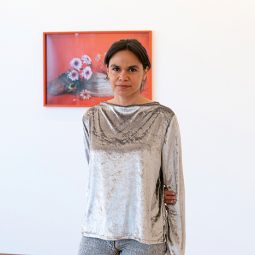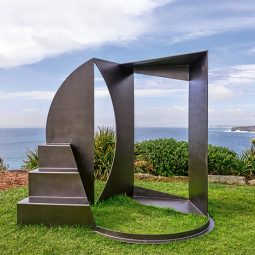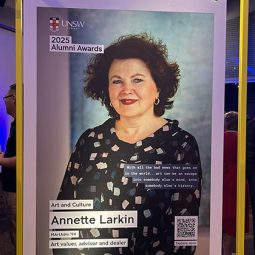Recently Laraine Deer travelled to Berlin in Germany. This is an excerpt from her journal about a walking tour of street art that she attended in one of the more interesting districts that is Friedrichshain-Kreuzberg, where the culture of street art has flourished since the unification of East and West and the removal of the Berlin Wall.
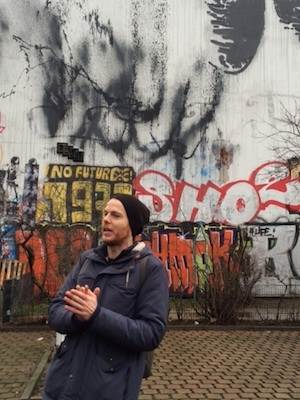
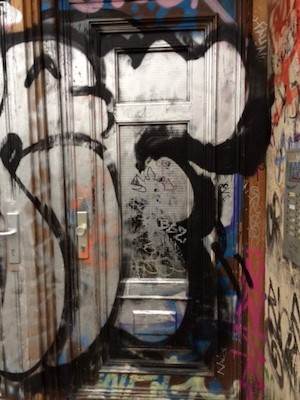
‘Berlin is home to some of the best street art that I have seen in the world. With the unification of East and West new locations, both industrial and residential, are ripe for the picking. Today I am taking a walking tour with Robert, a street artist who leads small groups around to see the best of Berlin’s street art.
On this cold mid winter’s morning the meeting place is Alexanderplatz, but this area is far too upbeat for our tour. First up we hop on a train and go to Korbussor Tor (very close to our apartment) where our tour begins at the train station at Kreuzberg. Robert gives an introduction about street art in Berlin and its legacy of artists coming from all parts of the world such as Brazil.
Before we go any further, let me describe what I’m seeing. Here in Kreuzberg, there is a watermark of tagging at ground level on all the buildings for as far as I can see. I am not seeing street art per se as much as ‘tagging’. The aesthetic of tagging is raw and grungy, it is everywhere. Tagging is the signature artwork of an artist and it should take very little time to produce. Less than a minute is preferred. I find tagging harsh but my reality is biased as I have just come from one of the most inspiring city’s in Europe, Florence, which is renowned for it’s beauty, for me the difference between the two cities is extreme.
In the meantime, my travelling companions are camera ready and keen to get started. Our walk brings us to a large building and I am looking at a giant image of an astronaut. This work, Astronaut/ Cosmonaut, (2007), is by Victor Ash who developed the idea for this piece when he first saw a cast shadow of a flag on this empty wall at night. Ash made this piece so that the shadow of the flag now sits in the astronauts right hand. His intention is for the shadow and the astronaut to be seen as one image when viewed at night. The flag itself is attached to a pole across the road at the BMW car dealership.
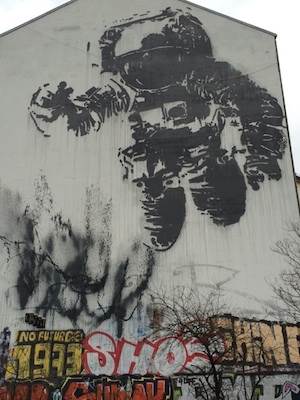
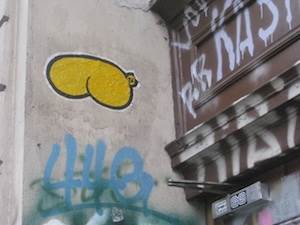
Our guide informs us that Berlin is broke since the unification which cost billions of Euros. There is a government department assigned to the removal of graffiti, it is made up of 37 people, it’s considered a small problem. Fines are based on size and time taken to remove the graffiti so big fines don’t happen very often as most of the graffiti is small. Very few people seem to get caught anyway. Street artists are very fast and efficient at their craft.
We move on further through the streets and Robert talks about techniques that are employed by graffiti artists. Creating artworks can be a dangerous occupation especially when trying to get the best location at the top of the building. Some artworks may require the artist scaling downwards (like abseiling) from the top of the building several times. We are now looking at a distinctive wall made up of red and black marks that look something like the designs of playing cards. Red marks followed by black marks and so on, running alternatively down the wall. There are three distinct rows of markings across this building meaning the artist has scaled the building three times.
I ask him about the gender politics of street art and he shows us the work of a female French artist called Pou it is a stencil paste-up of a backside, but it is hard to distinguish whether it could be women’s breasts or as our guide suggests male genitals too. That is her signature style.
We turn another corner to find an artwork that is very familiar, it’s Roa, a Dutch artist whose artwork are very distinctive in the depictions of wild animals that always pertain to the origins of the area he is working in. It is hard to see the whole of this piece without interference from billboards at the bottom and other art along the side. What I can see is several animals hanging upside down by rope that looks like it is attached to the top of the building. There is a hare, a crane, a deer and a goat. These animals look like they have been hung and quartered. The image before me is striking and unique. After chatting about the artist our host launches into a diatribe about a group of Berlin street artists who make an artwork alongside original and well known artworks. The other work is so close that is it impossible to get a photograph of Roa’s work without the other work in the shot. Famous by association, our host does not say who the other work belongs to.
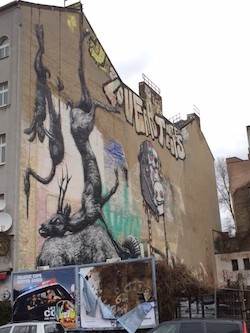
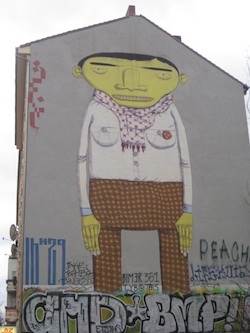
Walking a little further we come to an artwork that takes up a 4 story building by the South American twins ‘Os Gemeos’ from San Paulo, Brazil. It’s a figure, developed from South American folklore mixed with New York graffiti with their signature yellow skin, the scale alone is impressive and the colours used are complimentary to the surrounding buildings, I love it! I’m warming up now both physically and mentally, coffee in hand we move on. Standing in front of these artworks, I’m starting to appreciate their scale and location – a four story building is mighty high from ground level.
There are plenty of photo opportunities along the footpaths as we head in the direction of the Berlin Wall in Friedrichshain. Another story along the way is about an artist called Blu, from Bologna, Italy. We turn the corner to find a giant image of a figure from the waist up. Made up of tiny bodies, squirming and writhing, it reminds me of Dante’s inferno. We walk a little further and come to an open area with a railway bridge, there are lots of interconnecting rail lines here and a vast, empty factory site. Our guide shows us some artwork in the distance, two pieces with very large black figures (chest to head) taking up two buildings side be side. Robert tells us that these have been recently painted over in black paint by the artist, Blu. The land around this ex factory site has been bought by developers and the new plans show that these huge artworks will be obscured by the new development and only the new occupants will have the privilege of seeing them. In opposition to this use of ‘public’ artwork the artist has blackened out the images.
We end the first part of tour here, we are now in the old East Berlin with the Berlin wall not far behind us. This is only a small taste of what is on offer in the streets of Berlin. Is Blu’s ‘un’ painting of his artwork a sign of what is to come when this part of the city becomes gentrified. This may be so but there is still a long way to go before change occurs in this wonderful old city.
Alternative Berlin Tours are located at alternativeberlin.com
